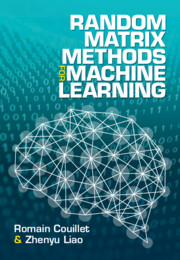Refine search
Actions for selected content:
6829 results in Communications and signal processing
Bibliography
-
- Book:
- Random Matrix Methods for Machine Learning
- Published online:
- 30 June 2022
- Print publication:
- 21 July 2022, pp 378-400
-
- Chapter
- Export citation
6 - Large-Dimensional Convex Optimization
-
- Book:
- Random Matrix Methods for Machine Learning
- Published online:
- 30 June 2022
- Print publication:
- 21 July 2022, pp 313-336
-
- Chapter
- Export citation
Index
-
- Book:
- Random Matrix Methods for Machine Learning
- Published online:
- 30 June 2022
- Print publication:
- 21 July 2022, pp 401-402
-
- Chapter
- Export citation
2 - Random Matrix Theory
-
- Book:
- Random Matrix Methods for Machine Learning
- Published online:
- 30 June 2022
- Print publication:
- 21 July 2022, pp 35-154
-
- Chapter
- Export citation
4 - Kernel Methods
-
- Book:
- Random Matrix Methods for Machine Learning
- Published online:
- 30 June 2022
- Print publication:
- 21 July 2022, pp 207-276
-
- Chapter
- Export citation
Preface
-
- Book:
- Random Matrix Methods for Machine Learning
- Published online:
- 30 June 2022
- Print publication:
- 21 July 2022, pp vii-viii
-
- Chapter
- Export citation
1 - Introduction
-
- Book:
- Random Matrix Methods for Machine Learning
- Published online:
- 30 June 2022
- Print publication:
- 21 July 2022, pp 1-34
-
- Chapter
- Export citation
Contents
-
- Book:
- Random Matrix Methods for Machine Learning
- Published online:
- 30 June 2022
- Print publication:
- 21 July 2022, pp v-vi
-
- Chapter
- Export citation
8 - Universality and Real Data
-
- Book:
- Random Matrix Methods for Machine Learning
- Published online:
- 30 June 2022
- Print publication:
- 21 July 2022, pp 364-377
-
- Chapter
- Export citation

Random Matrix Methods for Machine Learning
-
- Published online:
- 30 June 2022
- Print publication:
- 21 July 2022
Index of Special Symbols
-
- Book:
- Compound Renewal Processes
- Published online:
- 16 June 2022
- Print publication:
- 30 June 2022, pp 363-364
-
- Chapter
- Export citation
Frontmatter
-
- Book:
- Compound Renewal Processes
- Published online:
- 16 June 2022
- Print publication:
- 30 June 2022, pp i-iv
-
- Chapter
- Export citation
2 - Integro-Local Limit Theorems in the Normal Deviation Zone
-
- Book:
- Compound Renewal Processes
- Published online:
- 16 June 2022
- Print publication:
- 30 June 2022, pp 57-89
-
- Chapter
- Export citation
5 - Integro-Local Limit Theorems under the Cramér Moment Condition
-
- Book:
- Compound Renewal Processes
- Published online:
- 16 June 2022
- Print publication:
- 30 June 2022, pp 225-274
-
- Chapter
- Export citation
Contents
-
- Book:
- Compound Renewal Processes
- Published online:
- 16 June 2022
- Print publication:
- 30 June 2022, pp v-x
-
- Chapter
- Export citation
Appendix A - On Boundary Crossing Problems for Compound Renewal Processes when the Cramér Condition Is Not Fulfilled
-
- Book:
- Compound Renewal Processes
- Published online:
- 16 June 2022
- Print publication:
- 30 June 2022, pp 341-351
-
- Chapter
- Export citation
Basic Notation
-
- Book:
- Compound Renewal Processes
- Published online:
- 16 June 2022
- Print publication:
- 30 June 2022, pp 352-356
-
- Chapter
- Export citation
6 - Exact Asymptotics in Boundary Crossing Problems for Compound Renewal Processes
-
- Book:
- Compound Renewal Processes
- Published online:
- 16 June 2022
- Print publication:
- 30 June 2022, pp 275-324
-
- Chapter
- Export citation
Introduction
-
- Book:
- Compound Renewal Processes
- Published online:
- 16 June 2022
- Print publication:
- 30 June 2022, pp xi-xvi
-
- Chapter
- Export citation
3 - Large Deviation Principles for Compound Renewal Processes
-
- Book:
- Compound Renewal Processes
- Published online:
- 16 June 2022
- Print publication:
- 30 June 2022, pp 90-153
-
- Chapter
- Export citation
